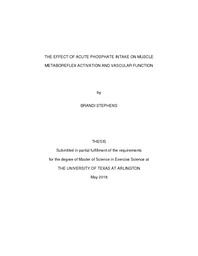| dc.description.abstract | Emerging evidence suggests that long term high consumption of inorganic phosphate (Pi) is associated with an increased risk of cardiovascular disease. Importantly, with the growing abundance of processed foods, dietary intake of Pi in the United States has doubled the daily-recommended allowance. Recently, Mizuno et al. demonstrated that chronic high dietary Pi consumption results in significantly exaggerated increases in mean arterial pressure (MAP) in response to exercise and muscle metaboreflex activation in rodents. Whether acute high Pi influences MAP responses in humans remains unknown. Notably, acute high Pi consumption has been shown to impair vascular function in healthy men, but a recent study does not support this finding. Therefore, the goal of this research was to investigate whether acute high Pi consumption affects exercise and muscle metaboreflex activation, and whether vascular function is also affected. To investigate, subjects performed static handgrip (HG) at 35% maximal voluntary contraction, followed by post-exercise ischemia (PEI) to isolate the muscle metaboreflex. Vascular function was assessed via brachial artery flow-mediated dilation (FMD), and arterial stiffness was assessed using pulse wave velocity (PWV). Pi group (N= 13; 23 ± 1 yrs; mean ± SEM) ingested a monosodium phosphate drink containing 2,000 mg of phosphorus and 1,520 mg of sodium, and a control group (N=5; 23 ± 2 yrs) ingested a drink containing 1,520 mg of sodium, to match the sodium amount in the Pi drink. After 60 minutes, measures were repeated and blood was drawn at 60 and 120 min post. Serum phosphate was significantly elevated at 60 min (baseline, 3.2 ± 0.2 mg/dL; 60 min, 4.5 ± 0.2 mg/dL; p<0.01) and 120 min (4.9 ± 0.3 mg/dL; p<0.01) post- Pi, but did not change with control (p=0.51). Metaboreflex-induced increases in MAP were not different following Pi (P=0.192) or Control (P=0.472). In contrast, macrovascular function only was significantly attenuated after Pi drink, (pre, 5.1± 0.5%; post, 3.2 ± 0.5%; p<0.01), with no changes with Control drink. For microvascular function, there were no differences pre vs. post with the Pi (P =0.721) or Control drink (P=0.302) and there were no differences in arterial stiffness following Pi drink (P=0.163) or Control drink (P=0.394). In summary, acute high Pi consumption did not affect the pressor response during exercise or muscle metaboreflex activation, or arterial stiffness, whereas macrovascular function was impaired. These data suggest a preserved pressor response, but peripheral macrovasculature is vulnerable to acute high Pi in young healthy men. | |


